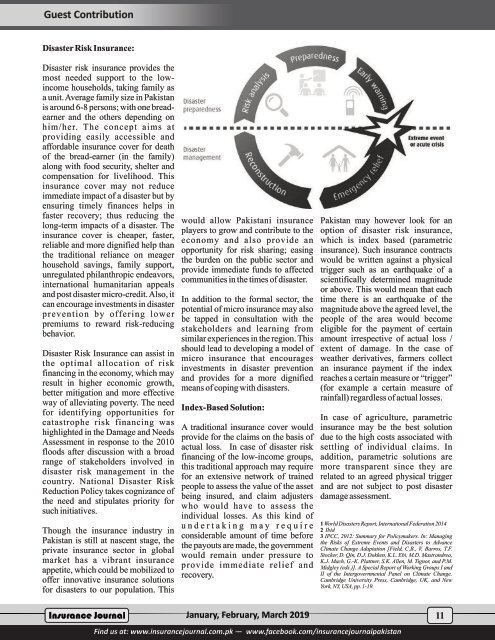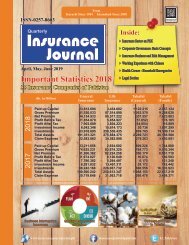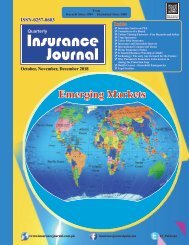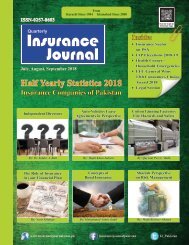Insurance Journal (1st Quarter 2019)
You also want an ePaper? Increase the reach of your titles
YUMPU automatically turns print PDFs into web optimized ePapers that Google loves.
Guest Contribution<br />
Disaster Risk <strong>Insurance</strong>:<br />
Disaster risk insurance provides the<br />
most needed support to the lowincome<br />
households, taking family as<br />
a unit. Average family size in Pakistan<br />
is around 6-8 persons; with one breadearner<br />
and the others depending on<br />
him/her. The concept aims at<br />
providing easily accessible and<br />
affordable insurance cover for death<br />
of the bread-earner (in the family)<br />
along with food security, shelter and<br />
compensation for livelihood. This<br />
insurance cover may not reduce<br />
immediate impact of a disaster but by<br />
ensuring timely finances helps in<br />
faster recovery; thus reducing the<br />
long-term impacts of a disaster. The<br />
insurance cover is cheaper, faster,<br />
reliable and more dignified help than<br />
the traditional reliance on meager<br />
household savings, family support,<br />
unregulated philanthropic endeavors,<br />
international humanitarian appeals<br />
and post disaster micro-credit. Also, it<br />
can encourage investments in disaster<br />
prevention by offering lower<br />
premiums to reward risk-reducing<br />
behavior.<br />
Disaster Risk <strong>Insurance</strong> can assist in<br />
the optimal allocation of risk<br />
financing in the economy, which may<br />
result in higher economic growth,<br />
better mitigation and more effective<br />
way of alleviating poverty. The need<br />
for identifying opportunities for<br />
catastrophe risk financing was<br />
highlighted in the Damage and Needs<br />
Assessment in response to the 2010<br />
floods after discussion with a broad<br />
range of stakeholders involved in<br />
disaster risk management in the<br />
country. National Disaster Risk<br />
Reduction Policy takes cognizance of<br />
the need and stipulates priority for<br />
such initiatives.<br />
Though the insurance industry in<br />
Pakistan is still at nascent stage, the<br />
private insurance sector in global<br />
market has a vibrant insurance<br />
appetite, which could be mobilized to<br />
offer innovative insurance solutions<br />
for disasters to our population. This<br />
would allow Pakistani insurance<br />
players to grow and contribute to the<br />
economy and also provide an<br />
opportunity for risk sharing; easing<br />
the burden on the public sector and<br />
provide immediate funds to affected<br />
communities in the times of disaster.<br />
In addition to the formal sector, the<br />
potential of micro insurance may also<br />
be tapped in consultation with the<br />
stakeholders and learning from<br />
similar experiences in the region. This<br />
should lead to developing a model of<br />
micro insurance that encourages<br />
investments in disaster prevention<br />
and provides for a more dignified<br />
means of coping with disasters.<br />
Index-Based Solution:<br />
A traditional insurance cover would<br />
provide for the claims on the basis of<br />
actual loss. In case of disaster risk<br />
financing of the low-income groups,<br />
this traditional approach may require<br />
for an extensive network of trained<br />
people to assess the value of the asset<br />
being insured, and claim adjusters<br />
who would have to assess the<br />
individual losses. As this kind of<br />
u n d e r t a k i n g m a y r e q u i r e<br />
considerable amount of time before<br />
the payouts are made, the government<br />
would remain under pressure to<br />
provide immediate relief and<br />
recovery.<br />
Pakistan may however look for an<br />
option of disaster risk insurance,<br />
which is index based (parametric<br />
insurance). Such insurance contracts<br />
would be written against a physical<br />
trigger such as an earthquake of a<br />
scientifically determined magnitude<br />
or above. This would mean that each<br />
time there is an earthquake of the<br />
magnitude above the agreed level, the<br />
people of the area would become<br />
eligible for the payment of certain<br />
amount irrespective of actual loss /<br />
extent of damage. In the case of<br />
weather derivatives, farmers collect<br />
an insurance payment if the index<br />
reaches a certain measure or “trigger”<br />
(for example a certain measure of<br />
rainfall) regardless of actual losses.<br />
In case of agriculture, parametric<br />
insurance may be the best solution<br />
due to the high costs associated with<br />
settling of individual claims. In<br />
addition, parametric solutions are<br />
more transparent since they are<br />
related to an agreed physical trigger<br />
and are not subject to post disaster<br />
damage assessment.<br />
1 World Disasters Report, International Federation 2014<br />
2 Ibid<br />
3 IPCC, 2012: Summary for Policymakers. In: Managing<br />
the Risks of Extreme Events and Disasters to Advance<br />
Climate Change Adaptation [Field, C.B., V. Barros, T.F.<br />
Stocker, D. Qin, D.J. Dokken, K.L. Ebi, M.D. Mastrandrea,<br />
K.J. Mach, G.-K. Plattner, S.K. Allen, M. Tignor, and P.M.<br />
Midgley (eds.)]. A Special Report of Working Groups I and<br />
II of the Intergovernmental Panel on Climate Change.<br />
Cambridge University Press, Cambridge, UK, and New<br />
York, NY, USA, pp. 1-19.<br />
<strong>Insurance</strong> <strong>Journal</strong> January, February, March <strong>2019</strong><br />
11<br />
Find us at: www.insurancejournal.com.pk — www.facebook.com/insurancejournalpakistan

















